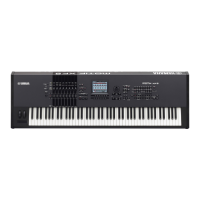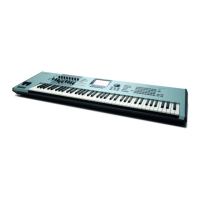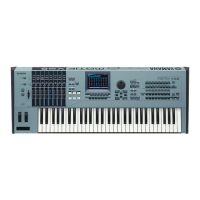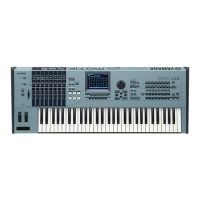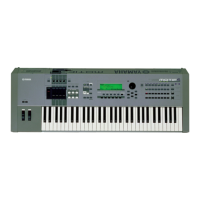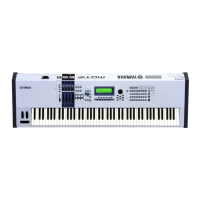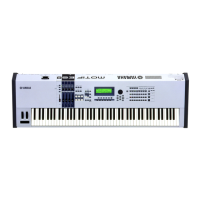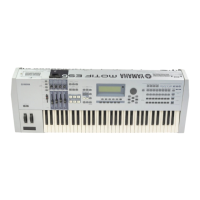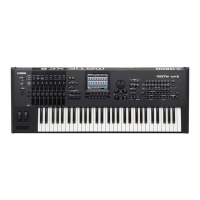
Do you have a question about the Yamaha MOTIF XF6 and is the answer not in the manual?
| Polyphony | 128 notes |
|---|---|
| Multitimbral Capacity | 16 parts |
| Wave ROM | 741 MB (when converted to 16-bit linear format) |
| Keyboard | 61 keys |
| Sound Engine | AWM2 |
| Preset Voices | 1, 024 |
| User Voices | 128 |
| Effects | Reverb, Chorus, Part EQ |
| Sequencer | 16-track |
| Arpeggiator | Yes |
| Display | 320 x 240 dot, backlit LCD |
| Connectors | MIDI IN/OUT, USB |
| Storage | Flash Memory |
| Power Supply | AC IN |
Explains safety graphics on the enclosure, like shock warnings.
Covers battery disposal guidelines and environmental concerns.
Disclaimers regarding product modification and warranty coverage.
Defines cautionary symbols used in the manual for user safety.
Essential guidelines for safe operation and maintenance.
Essential safety warnings to prevent electrical shock and hazards.
Precautions to prevent physical injury or damage to the instrument.
Advice on safe handling, listening habits, and preventing damage.
Information on checking for and updating the latest firmware.
Introduction to the instrument's features and design philosophy.
Explains the structure of the manual and available PDF resources.
Lists the items included with the instrument.
Information on DAW software, installation, and support.
Details on the XA feature for realistic sound recreation.
Information on the integrated SDRAM for audio sampling.
Features for recording and playing back audio files.
Description of the keyboard, pitch bend, modulation, and ribbon controllers.
Functionality of assignable buttons and the eight control knobs.
Function of multi-part control and effect activation buttons.
How to manage Arpeggio playback and remote control functions.
Explanation of the LCD display and F1-F6 function buttons.
Functionality of data dial, cursor, exit, enter, and mode buttons.
Buttons for selecting numbers, banks, and groups for various modes.
Using category search and performance control features.
Identification of rear panel connectors like USB, Ethernet, MIDI.
Details on digital audio output and MIDI ports.
Connections for foot switches and controllers.
Description of main audio outputs and external audio inputs.
Instructions for connecting the AC power cord.
Guide to connecting external audio monitoring equipment.
Procedure for safely powering the instrument and connected devices on/off.
How to adjust master volume and display contrast.
Instructions for listening to and selecting demo songs.
Procedure to load factory default demo songs and patterns.
Restoring the instrument to its original factory default settings.
Navigating the interface using cursor buttons and highlighting items.
Methods for changing parameter values using the dial and buttons.
How to utilize function and sub-function buttons for various tasks.
Method for entering text names for data like Voices or Songs.
Adjusting parameter ranges based on key presses or velocity.
Using pop-up lists to select desired parameters efficiently.
Playing and creating individual instrument sounds (Voices).
Layering or splitting multiple Voices for complex sounds.
Recording, editing, and playing multi-track MIDI sequences.
Recording external audio signals to create samples.
Managing data files, saving, loading, and audio recording.
Setting global system parameters and preferences.
Steps to select and play factory preset Voices.
Efficiently finding Voices using category and sub-category filters.
How to trigger rhythm patterns and phrases with keyboard playing.
How to assign different Arpeggio types to SF buttons.
Overview of controllers like pitch bend, modulation, and ribbon.
Real-time sound manipulation using the instrument's knobs.
Process of creating and editing Voices, including Elements.
Applying reverb, chorus, and insertion effects to Voices.
Saving modified Voices to internal memory.
Steps to select and play pre-programmed Performances.
Interpreting the display information in Performance mode.
Explains how Voices are assigned to the four Parts of a Performance.
Different ways to structure Performances: Layer and Split.
Combining multiple Voices to create a richer sound.
Steps to reset a Performance to its default state.
Adjusting Arpeggio parameters for individual Parts.
How to save a created Performance to internal memory.
Overview of how keyboard performance is recorded into tracks.
Steps for recording keyboard playing into a Song.
Recording Arpeggio patterns directly into a Pattern.
Steps to capture your keyboard performance as audio data.
How to playback WAV and AIFF audio files from storage.
Storing custom setups as Master Programs for quick recall.
Configuring Zones and parameters for master keyboard functionality.
Detailed configuration of Zones and their parameters.
Definitions of key terms used in Song recording.
Overview of playback functions, track mute, and track solo.
Controlling individual Part volumes using the panel sliders.
Steps for recording performance data to a specific track.
Continuing the process of recording performance data to a track.
Editing and correcting recorded MIDI events and notes.
Recording songs by utilizing the powerful Arpeggio playback features.
Applying a swing feel to recorded tracks using the Play Effect.
How to save the recorded Song to internal memory.
Understanding Pattern mode structure, sections, and playback.
Exploring preset patterns for musical inspiration and ideas.
Inspecting phrase assignments to tracks within patterns.
Building patterns by utilizing the Arpeggio feature.
Arranging pattern sections into a sequence for Song creation.
Saving created patterns to the instrument's internal memory.
Transforming a Pattern Chain into a Song structure for accompaniment.
Adding melodic parts to a song over pre-recorded backing patterns.
Adjusting parameters for multi-timbral playback in Song/Pattern modes.
Initial configuration steps for recording external audio signals.
Step-by-step guide for recording audio samples.
Editing recorded samples, including setting start/end points.
Saving edited samples as waveforms to memory.
Steps for sampling audio specifically for use in Pattern mode.
Editing samples using the Slice function for tempo and rhythmic adjustments.
Recording single audio events for integration into Songs.
Storing waveforms to the optional Flash Memory Expansion Module.
Configuring auto-load and power-on modes for specific tasks.
Customizing the visual appearance of the instrument's display.
How to adjust the instrument's overall tuning for ensemble playing.
Shifting the instrument's pitch up or down in semitones.
Steps for connecting the instrument to a computer using a USB cable.
Understanding MIDI data transmission pathways and ports.
Instructions for connecting the instrument via an IEEE1394 cable.
Visualizing the flow of audio and MIDI data over an IEEE1394 connection.
Details on MIDI communication using the IEEE1394 interface.
Using the instrument as a sound source for DAW playback.
Capturing MOTIF XF performances directly into DAW software.
Configuring the instrument for optimal computer connectivity.
Configuring DAW software for seamless instrument integration.
Connecting and utilizing external MIDI tone generators.
Utilizing the instrument as a computer's audio interface.
Operating DAW software functions directly from the MOTIF XF.
Listing DAW applications compatible with remote control.
Configuring the instrument and DAW for remote operation.
Operating DAW functions directly from the MOTIF XF panel.
Utilizing the VST Editor for advanced parameter control and editing.
Procedure for saving instrument settings to a USB storage device.
Procedure for loading instrument settings from a USB storage device.
Information and precautions for using USB storage devices.
Explanations for various LCD messages and their meanings.
Further explanations of LCD messages and their meanings.
Steps to diagnose and fix problems related to no audio output.
Steps to identify and resolve distorted audio output.
Steps to fix issues where sound abruptly stops during playback.
Resolving issues where only one note sounds at a time.
Steps to fix problems with wrong pitch or interval settings.
Steps to resolve issues where effects are not applied.
Steps to resolve issues with starting or stopping Arpeggio playback.
Troubleshooting sound differences between Voice and Performance modes.
Steps to fix issues where Song/Pattern playback fails to start.
Troubleshooting recording failures and computer communication issues.
Resolving sound output problems when using computer or MIDI instruments.
Steps to resolve problems with network connectivity.
Troubleshooting problems with MIDI bulk data transmission/reception.
Troubleshooting issues encountered when saving data to USB storage.
Important safety and handling precautions before installing hardware.
Detailed instructions for installing the FW16E expansion board.
Steps for installing FL512M/FL1024M memory modules.
Detailed specifications for keyboards, tone generator, sampling, sequencer.
Additional specifications including controllers, connectors, power, and dimensions.
Compliance information and warnings for U.S. users.
Wiring instructions for the power cord in the United Kingdom.
Warranty information specific to European Economic Area and Switzerland.
Contact details for Yamaha's various European offices.
